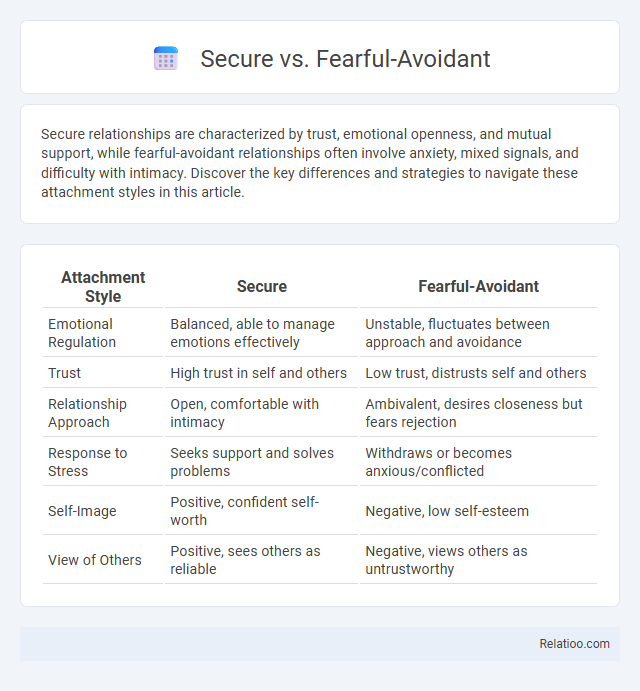Secure relationships are characterized by trust, emotional openness, and mutual support, while fearful-avoidant relationships often involve anxiety, mixed signals, and difficulty with intimacy. Discover the key differences and strategies to navigate these attachment styles in this article.
Table of Comparison
| Attachment Style | Secure | Fearful-Avoidant |
|---|---|---|
| Emotional Regulation | Balanced, able to manage emotions effectively | Unstable, fluctuates between approach and avoidance |
| Trust | High trust in self and others | Low trust, distrusts self and others |
| Relationship Approach | Open, comfortable with intimacy | Ambivalent, desires closeness but fears rejection |
| Response to Stress | Seeks support and solves problems | Withdraws or becomes anxious/conflicted |
| Self-Image | Positive, confident self-worth | Negative, low self-esteem |
| View of Others | Positive, sees others as reliable | Negative, views others as untrustworthy |
Understanding Attachment Styles: Secure vs Fearful-Avoidant
Secure attachment is characterized by trust, emotional openness, and healthy boundaries, allowing individuals to form stable, supportive relationships. Fearful-avoidant attachment involves anxiety and avoidance due to past trauma or inconsistent caregiving, leading to ambivalent behavior and difficulty trusting others. Understanding these attachment styles helps identify patterns in emotional regulation and relationship dynamics, promoting personal growth and improved interpersonal connections.
Defining Secure Attachment
Secure attachment is characterized by trust, emotional openness, and healthy communication, allowing individuals to form stable and supportive relationships. Unlike Fearful-Avoidant attachment, where fear of rejection and intimacy creates emotional distance, secure attachment fosters confidence in both giving and receiving love. Your ability to connect authentically with others strengthens through secure attachment, promoting resilience and emotional well-being.
Defining Fearful-Avoidant Attachment
Fearful-avoidant attachment is characterized by a conflicting desire for intimacy coupled with a deep fear of rejection, leading to unpredictable and ambivalent behaviors in relationships. Unlike secure attachment, which fosters trust and emotional openness, fearful-avoidant individuals struggle with vulnerability and often distance themselves to protect against potential hurt. This attachment style results from inconsistent caregiving, causing heightened anxiety and avoidance patterns that complicate forming stable, secure bonds.
Core Differences Between Secure and Fearful-Avoidant
Core differences between Secure and Fearful-Avoidant attachment styles center on emotional regulation and relationship trust. Secure individuals maintain healthy boundaries and consistent emotional availability, while Fearful-Avoidant individuals struggle with intimacy due to deep fears of rejection and abandonment. You can achieve healthier connections by understanding these distinctions and fostering self-awareness around relationship patterns.
Emotional Responses in Secure vs Fearful-Avoidant Individuals
Secure individuals exhibit consistent emotional regulation, allowing them to express feelings openly and recover quickly from stress, fostering healthy interpersonal connections. Fearful-Avoidant individuals often experience intense inner conflict, leading to emotional suppression and heightened anxiety in relationships, which impairs trust and intimacy. Understanding these distinct emotional response patterns is crucial for tailoring therapeutic interventions that address attachment-related challenges effectively.
Communication Patterns in Relationships
Secure attachment fosters open and honest communication, where both partners express feelings confidently and listen actively, creating a foundation of trust. Fearful-avoidant attachment often leads to inconsistent communication patterns, marked by fear of intimacy and difficulty expressing emotions, which can cause misunderstandings and emotional distance. You can improve relationship dynamics by recognizing these patterns and promoting secure communication to enhance mutual understanding and connection.
Conflict Resolution: A Comparative Approach
Secure attachment promotes healthy conflict resolution by encouraging open communication and empathy, fostering mutual understanding and trust in relationships. Fearful-avoidant attachment often leads to withdrawal or ambivalence during conflicts, creating barriers to resolution due to fear of intimacy and rejection. Understanding these patterns allows you to adopt strategies that enhance emotional safety and constructive dialogue, improving your conflict management skills.
Impact on Intimacy and Trust
Secure attachment fosters open communication and emotional availability, significantly enhancing Your ability to build trust and deep intimacy in relationships. Fearful-avoidant attachment often leads to mixed signals and emotional distancing, which can hinder trust and create barriers to genuine intimacy. Compared to fearful-avoidant, secure attachment provides a stable foundation where You feel safe to express vulnerability, strengthening the emotional connection and mutual trust with your partner.
Challenges and Growth Opportunities
Secure attachment fosters resilience and effective communication, enabling individuals to navigate challenges with emotional stability and openness to growth. Fearful-avoidant attachment presents difficulties in trust and vulnerability, often leading to interpersonal conflicts but offers opportunities for self-awareness and improved emotional regulation through therapy or mindful practices. Comparing secure and fearful-avoidant attachment styles highlights the potential for transformation by addressing fear-based avoidance patterns and cultivating secure relational behaviors.
Supporting Healthy Relationship Dynamics
Secure attachment fosters open communication, trust, and emotional availability, which are essential for healthy relationship dynamics. Fearful-avoidant attachment often leads to mixed signals and emotional withdrawal, hindering intimacy and consistent support between partners. Promoting secure attachment styles through therapy and self-awareness can enhance relationship stability and mutual respect.

Infographic: Secure vs Fearful-Avoidant
 relatioo.com
relatioo.com